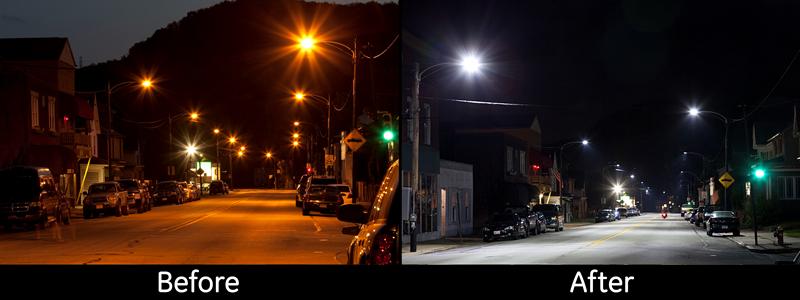 West Mayfield Borough has begun replacing its street lights with new energy efficient light emitting diode (LED) fixtures.
West Mayfield Borough has begun replacing its street lights with new energy efficient light emitting diode (LED) fixtures.
“Our goal is to replace all 103 street lights incrementally,” said Councilman Jim Bostek, who manages the new effort to save taxpayers money by lowering the borough’s energy bills through Duquesne Light’s LED Municipal Street Light Conversion Pilot Program.
The borough is scheduled to replace twenty lights by the end of 2014, forty lights in 2015, and the remaining 43 lights by 2016.
The first twenty LED street lights are being installed on 37th St. and Rock Avenue.
LED Street Lights Save Energy and Money
The LED Municipal Street Light Conversion Pilot Program helps municipalities convert a minimum of 10 street lights (70 Watt & 150 Watt High Pressure Sodium) to their equivalent 43 Watt and 106 Watt Cobrahead LED fixtures.
Municipal street lighting is costly. In 2014 West Mayfield Borough budgeted $20,000 to cover street lighting. As of August, the borough spent more than $11,759 to illuminate roadways.
According to a recent study by Carnegie Mellon University, municipalities typically spend up to 40% of their electricity budget on outdoor public lighting. West Mayfield’s existing sodium vapor and incandescent-style street lights currently consume 59% its electricity budget.
Until the recent availability of affordable LED street light technology, the only way municipalities could reduce their lighting cost was to remove street lighting where it is not needed, as West Mayfield did over the past decade—with noticeable complaints from many residents, pedestrians, and motorists.
Traditional lights cost between $50 and $100, but the new energy efficient LED street lights are more expensive to purchase, averaging between $200 to $300 each, and there are removal costs involved.
However, researchers at Carnegie Mellon University estimate that LED street lights use 50-90% less energy to operate, yielding 40-70% savings in operating costs.
“In addition to benefitting the environment and reducing light pollution,” said Mr. Bostek, “taxpayers will realize an immediate savings of $3 per light in monthly operating costs. And within three years we expect to recover the cost of replacing our old lights.”




